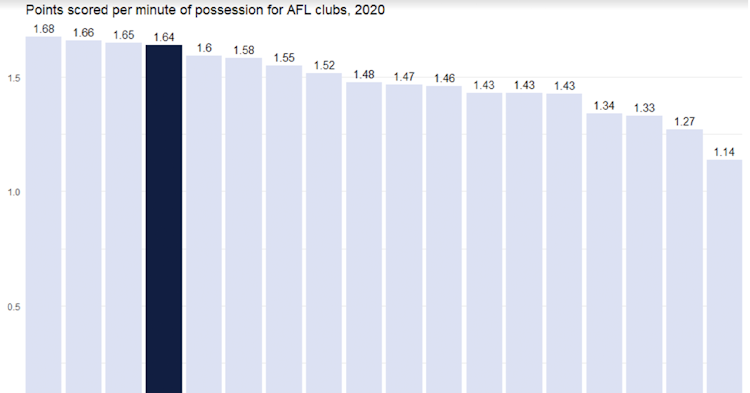'Under New Management': How David Teague Has Reshaped Carlton
Last updated: Jul 23, 2020, 2:29AM | Published: Jul 22, 2020, 1:36AM
Today we’re kicking off a new series here at Stats Insider, where over the next six weeks I will take a look at each of the AFL’s new senior coaches in 2020, and the impact they’re having on their clubs.
We will break it down across five key areas in particular: how well they’re winning the ball, moving the ball, scoring, defending, and the demographics of the sides they’re putting on the field.
Let’s take a look at the numbers.
RELATED: Give It A Break: Do Shorter Turnarounds Really Disadvantage AFL Teams?
WINNING THE BALL
The two most common ways for AFL sides to get their hands on the ball are winning it at the clearances, and forcing the opposition to turn it over. Carlton have become better at both under David Teague.
In Brendon Bolton’s 2019 matches, they had a -0.45 clearance differential, but under Teague’s leadership, they’ve averaged +2.45 clearances on their opponents, the fifth-bestin the league in that time.
A similar improvement has come about in ground ball gets, there they were -4.46 against their opponents under Bolton, but under Teague’s leadership now go at +1.94, ranked eighth in the league.
Looking at Carlton’s ability to apply pressure and tackles per minute of opposition possession, Teague’s Blues don’t seem all that different to Bolton’s.
They’ve hovered at around the same mark in both categories and are averaging less than one tackle per minute in 2020, ranked 18th in the competition.
However, when looking instead at the outcome of their pressure, Teague’s Blues have shown that they force their opponents into a turnover much more quickly than they did under Bolton.
In 2020, it’s taking them 41 seconds on average to create a turnover, much better than 48 seconds under Bolton, and a rise from 18th to 5th in the competition.
Not all tackles or pressure acts are created equally. While the Blues may not be applying them at a great volume, it’s clear the pressure they put on is getting results.
RELATED: Understanding how Clearances Shape the Results of AFL Games
MOVING THE BALL
The reverse of how quickly you make your opponents cough up the ball is how long you can hold onto it yourself, and this is an area where Carlton have also improved.
They retained possession for 39 seconds on average under Bolton in 2019, but are keeping the ball in hand for an extra three seconds in 2020, ranked ninth.
Under both Bolton and Teague the Blues have been a side that moves the ball forward quicker than most. In 2020, they’re averaging 112 metres gained per minute of opposition.
It’s important to note that this isn’t always a good thing - the 0-7 Crows for example are one of the four sides ranked higher than Carlton for this stat– but the Blues seem to be managing it well.
Other sides may seek to move the ball more slowly and control the uncontested possession, but the Blues are averaging a ratio of only 1.4 uncontested to contested possessions, 15th in the league.
What they are doing instead is kicking it whenever the opportunity presents, which no doubt goes hand in hand with their quick progress up the ground.
Carlton’s 1.87 kick to handball ratio under Teague in 2020 is the highest of any side in the competition.
In a lot of respects, these numbers remain fairly similar to what they were under Bolton, who also coached the Blues to kick more often and had a relatively low amount of uncontested possession.
But again it’s clear that where Bolton didn’t get outcomes, Teague does. The Blues had a -12 inside 50 differential per match under Bolton in 2019 – in 2020 they’re going at -0.7, which is still not in the black, but a significant improvement.
RELATED: 'Breaking the shackles'- Are the Blues really back?
SCORING
 The Blues have become known as a more potent attacking side under Teague, and this is very much
reflected in the stats.
The Blues have become known as a more potent attacking side under Teague, and this is very much
reflected in the stats.
Under Bolton in 2019 they managed to score just 1.42 points per minute, ranked 17th in the league, but this is an area that Teague quickly addressed, and has continued to improve.
In 2020, they’re scoring 1.64 points per minute, making them the fourth most potent side in the competition for this stat.
A big part of this is how much more directly they’re moving the ball towards. The Blues are averaging 6.7 disposals per inside-50 in 2020, a significant improvement from 7.6 under Bolton last year, and good enough to be ranked 5th in the league.
They’re also proving better at turning the inside-50s they do achieve into goals. In Bolton’s 2019 games, they were ranked 11th in the league, scoring goals from 21.1% of inside 50s.
In 2020, they’re going at 23.7%, which puts them fourth in the competition emphasising their significant improvement in scoring ability.
RELATED: Size Matters: The Types Of Forwards Scoring For And Against Your Club
DEFENDING
The other end of the scale, Carlton’s defensive stats represent the one area of their game that hasn’t seen significant improvement under Teague.
They were conceding 1.62 points per minute under Bolton, under Teague, they’re going at 1.59. That’s an incremental improvement in the raw numbers, but, relevant to the rest of the competition, they’ve slid from 11th to 16th as other sides have taken bigger steps forward.
Under Bolton in 2019, opposition players scored a goal from 46.1% of shots, but in 2020 this has increased to 50.7%.
It’s likely more than just bad luck - it suggests that under Teague, Carlton’s defence is allowing opposition sides to create more easily convertible shots at goal than they did under Bolton.
Opposition sides are averaging slightly less disposals per inside-50, and slightly more goals per inside 50 versus Teague’s coaching than they did versus Bolton’s, but in neither case by so large an amount as to be cause for alarm.
It’s an area where there was room for improvement to start with, and for now that remains the case under new management.
RELATED: Does defence still matter in the modern AFL?
DEMOGRAPHICS
 One of the most notable changes under Teague has come not in the way Carlton plays, but the
kind of team they put out on the field.
One of the most notable changes under Teague has come not in the way Carlton plays, but the
kind of team they put out on the field.
Under Bolton in 2019, they were ranked 16th for average age and 18th for average experience, but under Teague in 2020 they are sixth in both categories.
This is a pretty significant move up the rankings in a short space of time. However, it’s important to note that the presence of two 300-game veterans in Kade Simpson and Eddie Betts has a significant, probably disproportionate impact on these numbers.
Playing Betts over a rookie small forward makes the team 300 games more experienced week to week, but should our expectations of their performance necessarily increase in line with that? Probably not.
Arguably a better measure of age and experience – a topic I’ll explore more in a separate piece next week - for AFL teams is the median.
The median picks out the middle value from the 22 (specifically, the number halfway between the 11th and 12th ranked players). As such it isn’t influenced by whether the most experienced player in the side has played 150 games or 300 games - only the middle value counts.
If we look at the Blues through this measure there’s two major takeaways: Bolton’s Blues were even younger than we realised, and Teague’s aren’t as old as the average makes them look.
Bolton’s 2019 sides were ranked 18th in both median age and median experience, whereas the 2020 Blues are 9th in both categories.
Teague is clearly fielding older sides than Bolton did, but only to the point of being middle-of-the-pack compared to the rest of the competition.
RELATED: How Different Weather Conditions Affect AFL Performance
CLOSING THOUGHTS
Overall, it’s hard not to be impressed with what Teague has achieved in his short time as senior coach.
Brendon Bolton was a coach who put defence as his top priority, but still achieve only below-average performance in that area.
Carlton’s defensive performance may not have improved under Teague, but his decision to refocus the team on attacking footy has paid dividends.
It has put the Blues up there as one of the best attacking sides in the game, and aside from simply winning more games, made them more enjoyable to watch.
The demographic numbers suggest that Teague has made a significant departure from Bolton’s youth-focused selection policy, putting much older sides on the park.
This being the case, it would likely be a mistake to suggest that all of Carlton’s recent improvement has come from the development of the kids – refreshed veterans have been big contributors.
That’s not necessarily a bad thing. One could reasonably argue that making young players work harder for opportunities and allowing them to play in a more organised and successful team when they do earn their spot is far better for their development than simply throwing them to the wolves every week.
And the fact that the likes of Harry McKay, Jacob Weitering and Will Setterfield are amongst Carlton’s most notable improvers in 2020 suggests the younger Blues are still very much making progress.
It'd be a mistake to assume that it will be linear progress from here on out for Carlton, who may take steps forward and back as veterans retire and their young players develop further over time.
But be that as it may, it’s clear that there’s a lot to like about the direction David Teague is taking this club in.
Note: The stats on points from stoppages/possessions used in this article are recorded as they were published after each game in the Herald Sun.
For a small number of matches these stats were never published, and there is also known to be a small number of typographical errors in the original source data.
Did you enjoy this article? Join our free mailing list to get the best content delivered straight to your inbox, or join the conversation by leaving a comment below or on the Stats Insider Twitter or Facebook page.



